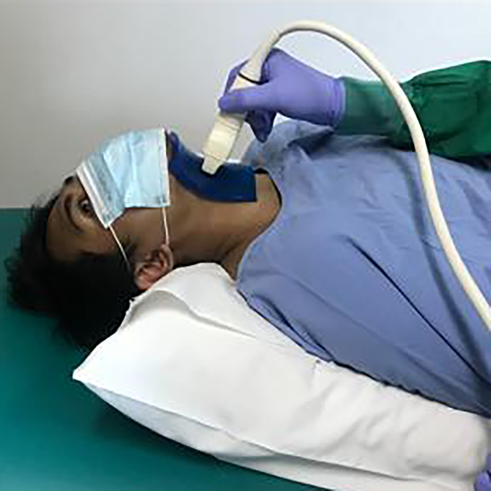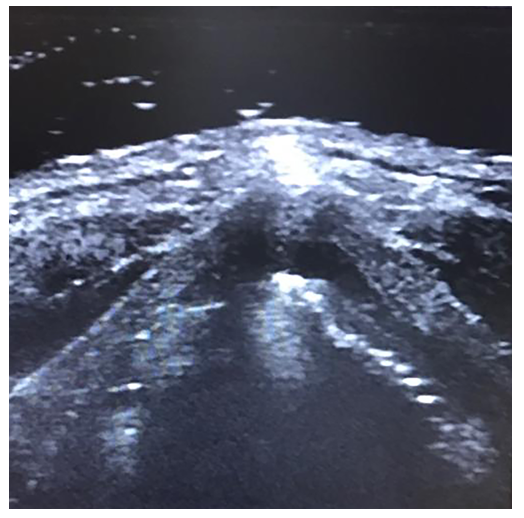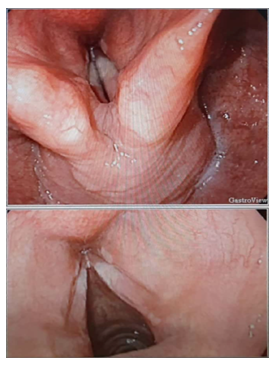TLUS (Transcutaneus Laryngeal Ultrasonography) as a safe option to evaluate vocal cords in COVID-19 Pandemic era: A Literature Review
Article Information
Erwin Danil Yulian1*, Alissa Rifa2
1Surgical Oncology Division, Department of Surgery, Faculty of Medicine Universitas Indonesia
2General Practitioner, Research Assistant in Surgical Oncology Division, Department of Surgery, Faculty of Medicine Universitas Indonesia
*Corresponding author: Erwin Danil Yulian, Department of Surgery, Dr. Cipto Mangunkusumo National Central General Hospital Building A, 4th Floor. Pangeran Diponegoro Street No. 71, Kenari, Senen. Central Jakarta. Indonesia 10430.
Received: 24 May 2021; Accepted: 31 May 2021; Published: 23 June 2021
Citation: Erwin Danil Yulian, Alissa Rifa. TLUS (Transcutaneus Laryngeal Ultrasonography) as a safe option to evaluate vocal cords in COVID-19 Pandemic era: A Literature Review. Journal of Surgery and Research 4 (2021): 373-379.
View / Download Pdf Share at FacebookAbstract
RLN palsy as a thyroid and parathyroid surgeries complication is usually diagnosed using a direct flexible laryngoscopy (DLF). During this pandemic, doing the DFL has become a major risk to the patient and to the doctor performing the examination as the procedure will allow the virus to aerosolize. Meanwhile, transcutaneous laryngeal ultrasonography (TLUS) has been the go-to procedure to diagnose the vocal cords. A literature searching was performed in the PubMed database in April 2021. 17 full text articles were assessed to review the TLUS modality usage to screen the vocal cords abnormalities in pandemic era. TLUS has a high sensitivity rate in screening abnormalities of the vocal cords. TLUS is considered as a safer option to DFL, thus it is much better fit to use while in pandemic state. When an abnormality is found, it should be confirmed using a DFL.
Keywords
Thyroid surgery, Vocal cord paralysis, Ultrasonography, COVID-19
Thyroid surgery articles; Vocal cord paralysis articles; Ultrasonography articles; COVID-19 articles
Thyroid surgery articles Thyroid surgery Research articles Thyroid surgery review articles Thyroid surgery PubMed articles Thyroid surgery PubMed Central articles Thyroid surgery 2023 articles Thyroid surgery 2024 articles Thyroid surgery Scopus articles Thyroid surgery impact factor journals Thyroid surgery Scopus journals Thyroid surgery PubMed journals Thyroid surgery medical journals Thyroid surgery free journals Thyroid surgery best journals Thyroid surgery top journals Thyroid surgery free medical journals Thyroid surgery famous journals Thyroid surgery Google Scholar indexed journals Vocal cord paralysis articles Vocal cord paralysis Research articles Vocal cord paralysis review articles Vocal cord paralysis PubMed articles Vocal cord paralysis PubMed Central articles Vocal cord paralysis 2023 articles Vocal cord paralysis 2024 articles Vocal cord paralysis Scopus articles Vocal cord paralysis impact factor journals Vocal cord paralysis Scopus journals Vocal cord paralysis PubMed journals Vocal cord paralysis medical journals Vocal cord paralysis free journals Vocal cord paralysis best journals Vocal cord paralysis top journals Vocal cord paralysis free medical journals Vocal cord paralysis famous journals Vocal cord paralysis Google Scholar indexed journals Ultrasonography articles Ultrasonography Research articles Ultrasonography review articles Ultrasonography PubMed articles Ultrasonography PubMed Central articles Ultrasonography 2023 articles Ultrasonography 2024 articles Ultrasonography Scopus articles Ultrasonography impact factor journals Ultrasonography Scopus journals Ultrasonography PubMed journals Ultrasonography medical journals Ultrasonography free journals Ultrasonography best journals Ultrasonography top journals Ultrasonography free medical journals Ultrasonography famous journals Ultrasonography Google Scholar indexed journals COVID-19 articles COVID-19 Research articles COVID-19 review articles COVID-19 PubMed articles COVID-19 PubMed Central articles COVID-19 2023 articles COVID-19 2024 articles COVID-19 Scopus articles COVID-19 impact factor journals COVID-19 Scopus journals COVID-19 PubMed journals COVID-19 medical journals COVID-19 free journals COVID-19 best journals COVID-19 top journals COVID-19 free medical journals COVID-19 famous journals COVID-19 Google Scholar indexed journals invasive procedures articles invasive procedures Research articles invasive procedures review articles invasive procedures PubMed articles invasive procedures PubMed Central articles invasive procedures 2023 articles invasive procedures 2024 articles invasive procedures Scopus articles invasive procedures impact factor journals invasive procedures Scopus journals invasive procedures PubMed journals invasive procedures medical journals invasive procedures free journals invasive procedures best journals invasive procedures top journals invasive procedures free medical journals invasive procedures famous journals invasive procedures Google Scholar indexed journals thyroid’s isthmus articles thyroid’s isthmus Research articles thyroid’s isthmus review articles thyroid’s isthmus PubMed articles thyroid’s isthmus PubMed Central articles thyroid’s isthmus 2023 articles thyroid’s isthmus 2024 articles thyroid’s isthmus Scopus articles thyroid’s isthmus impact factor journals thyroid’s isthmus Scopus journals thyroid’s isthmus PubMed journals thyroid’s isthmus medical journals thyroid’s isthmus free journals thyroid’s isthmus best journals thyroid’s isthmus top journals thyroid’s isthmus free medical journals thyroid’s isthmus famous journals thyroid’s isthmus Google Scholar indexed journals
Article Details
1. Background
USG has been a staple for surgeons to assess vocal cords prior to thyroid and parathyroid surgeries. It is also often referred as the stethoscope equivalent for the neck. Thyroid and parathyroid surgeries are the two most common invasive procedures in the endocrine medicine. There are two major complications for these operations, such as recurrent laryngeal nerve (RLN) palsy and surgical hypoparathyroidism [1]. The RLN palsy has the incidence rate of 9.8% for temporary palsy and 2.3% for permanent palsy [2]. These numbers were diagnosed using a direct flexible laryngoscopy (DLF). These palsy will cause the patient to experience hoarseness, choking, and aspiration due to unilateral palsy [3]. Meanwhile, patients who have anatomical abnormality were referred to ENT Surgeon. On march 11th 2020, WHO declared the Covid-19 virus as a global pandemic. Based on current data, it has a higher mortality rate compared to influenza [4,5]. During this pandemic, doing the DFL has become a major risk to the patient and to the doctor performing the examination as the procedure will allow the virus to aerosolize. Thus, this creates a demand to diagnose these abnormalities while maintaining the necessary health protocol that will create a safe environment for the examiner and examinee [6]. Hence, the transcutaneous laryngeal ultrasonography (TLUS) has been the go-to procedure to diagnose the vocal cords. Despite DFL is still the gold standard for diagnosing vocal cords, the TLUS is a non-invasive procedure, easy to learn, not constricted to be done by an ENT Surgeon, cheaper, and safer procedure to perform. According to the studies, DFL has a 99% visualization rate when evaluating vocal cords. This visualization rate is much higher when compared to TLUS. However, DFL is invasive, has a long term uncomfortable side effect for the examinee, needs local anesthesia, and has a chance to create an allergic reaction [5]. Considering all of those points, it is logical to prefer the safer non-invasive procedure. Nevertheless, TLUS is an operator dependent and skill dependent examination to do. This raises further discussion on considering this modality usage which will be elaborated in this review [7].
2. Review Results
A literature searching was performed in the PubMed database in April 2021. All English-language publications since 1996 to 2021 were obtained. We used search terms of ‘‘Transcutaneus Laryngeal Ultrasonography to Evaluate Vocal Cords in COVID-19 Pandemic Era’’. These were mainly based on the official thesaurus (MeSH). The initial searching results were screened through its title and abstracts. Thereafter, the potential original articles mainly focusing on TLUS were all identified. 17 full text articles were downloaded and reviewed to evaluate the TLUS usage on vocal cords abnormalities evaluations.
2.1 TLUS (Transcutaneus Laryngeal Ultrasonography)
TLUS is done using a USG 5-10-MHz (aperture 40 mm) linear transducer. The patient undergoing the procedure will be positioned in a supine position while having their neck hyperextended (Figure 1). For overweight and/or short-necked patient, a pillow under the neck will help further extend the neck. These USG examinations are performed to evaluate the neck vascularization, the two thyroid lobule, vocal cords, and thyroid’s isthmus [8].
The transducer is placed transversally on top of the thyroid cartilage while evaluating the vocal cords. Transducer should be moved craniocaudal until the two vocal cords are seen. If there are any difficulties in finding the vocal cords, the transducer should be placed on the lateral side of the acoustic window, which is the thyroid cartilage. If found correctly, true and false vocal cords will be seen alongside the artenoid cartilage (Figure 2). The true vocal cords will be hypoechoic and positioned right below the thyroid cartilage while false vocal cords will be more hyperechoic and positioned more caudally when compared to the true vocal cords. Another difference is that when saying the letter “I” true vocal cords will move symmetrically maintaining the abduction adduction [9-13].

Figure 1: Patient’s position, placement of the gel pad and ultrasound tranducer on the neck [13]

Figure 2: A superior view from below the thyroid cartilage. The image captures only main components, including the anatomic false and true vocal cords. However, as the patient speaks, dynamic assessment would show that normal true vocal cords move medially towards the midline in patients without nerve palsies [12].
2.2 DFL (Direct Flexible laryngoscopy)
DFL is performed while the patient maintains a semi recumbent position. Before the procedure, the patient is instructed to close the mouth and to breathe through their nose. Patient are given the topical anesthesia and decongestive medicine before the examination. The laryngoscope being used has 3.6mm diameter, inserted through the nose, to the nasal lining, until the lower side of the nasal septum. While the laryngoscope is being inserted, the patient is instructed to breathe through the nose. When the scope reaches the soft palate, the vocal cords will be seen (Figure 3). The patients is then asked to say the letter “I” allowing the examiner to evaluate the vocal cords [9].

Figure 3: Normomobile vocal cords to Direct Flexible laryngoscopy (DFL) - in adduction and abduction
3. Discussion
Evaluating vocal cords has been an integral and standard practice while doing a thyroid surgery. A guideline published by American Academy of Otolaryngology and Head and Neck Surgery suggests that all patient undergoing such surgery has to be evaluated on their vocal cords before and after the surgery using the DFL [4]. As previously stated, DFL is an invasive procedure that causes long term uncomfortable side effect and cannot be done by the surgeon alone. On the other hand, TLUS offers a cheaper, easier, and safer alternative to examined vocal cords before and after the surgery [8].
A study by Borel et al. stated that TLUS has a low sensitivity thus need a DFL to confirm the findings. In this study, TLUS only diagnosed 3 RLN palsies while DFL diagnosed 9 of all subjects. Borel et al. found that male gender and old age are two significant risk factors of having difficulties to diagnose RLN Palsy [14-17].
Building on this, a few of institutions suggest a new device that increases visualization, especially on men. Newest article suggests using a gel pad to increase the surface area between the neck and USG transducer. The article was published by Woo et al. that stated that the gel pad usage on 482 patients increases the visualization of TLUS from 93.4% to 99.0%, boosting the sensitivity of 98.0% to 98.0%, and the specificity of 99.7% to 99.8%. The gel pad usage is found significantly improving visualization of the vocal cords. Therefore, using a gel pad is a simple and easy way to increase the visualization [10].
Gambardella et al. reported a study involving 396 patients to compare the TLUS and DFL. TLUS showed a sensitivity of 97% and specificity 96% in detecting the vocal cords movement. They reported that only 14 out of 396 patients with difficulty of finding the vocal cords. In such cases, they used the lateral acoustic window to visualize the vocal cords. This study also showed that TLUS rarely over-diagnosed a patient on having a RLN palsy. 30 patients confirmed having RLN palsy using the DFL out of 47 patient suspected having RLN palsy using TLUS. Moreover, only 1 patient out of 396 patient ended up becoming a false negative [9].
While DFL is the gold standard, it still has many downsides. The examination is more expensive when compared to TLUS. DFL is considered an aerosol generating procedure thus requiring the staff and the patient to use a high level of PPE while performing the examinations [11,12]. This increases further the budget used. On the other hand, TLUS is a much cheaper and safer option. While TLUS is good on examining vocal cords before and after the thyroid surgery, TLUS findings highly depends on the operator skill while performing the examinations. As such, further course might be needed to further hone the surgeon skill to perform the TLUS.
4. Conclusion
Current studies proved TLUS boasts a high sensitivity rate while screening abnormalities of the vocal cords. TLUS is considered as a safer option to DFL, thus it is much better fit to use while in pandemic state. TLUS should be used before and after the thyroid surgery. When an abnormality is found, it should be validated using a DFL.
Clinical Significance
DFL is an aerosol generating procedure even though as a gold standard for evaluating vocal cords paralysis as a complication of thyroid surgery. Hence, TLUS is a safer option to use before and after thyroid surgeries in pandemic era.
Acknowledgment
Not applicable.
References
- Duclos A, Peix JL, Colin C, et al. Influence of experience on performance of individual surgeons in thyroid surgery: prospective cross sectional multicentre study. BMJ 344 (2012): 8041.
- Jeannon JP, Orabi AA, Bruch GA, et al. Diagnosis of recurrent laryngeal nerve palsy after thyroidectomy: A systematic review. Int J Clin Pract 63 (2009): 624-629.
- Wong KP, Mak KL, Wong CK, et al. Systematic review and meta-analysis on intra-operative neuro-monitoring in high-risk thyroidectomy. Int J Surg 38 (2017): 21-30.
- Chandrasekhar SS, Randolph GW, Seidman MD, et al. Clinical practice guideline: improving voice outcomes after thyroid surgery. Otolaryngology- head and neck surgery. Journal of American Academy of Otolaryngology- Head and Neck Surgery 148 (2013): S1-37.
- Sharma A, Price T, Mierzwa K, et al. Transnasal flexible laryngo-oesophagoscopy: An evaluation of the patient’s experirience. J Laryngol Otol 120 (2006): 24-31.
- Lacoste L, Karayan J, Lehuede MS, et al. A comparison of direct, indirect, and fiberoptic laryngoscopy to evaluate vocal cord paralysis after thyroid surgery. Thyroid 6 (1996): 17-21.
- Borel F, Delemazure AS, Espitalier F, et al. Transcutaneous ultrasonography in early post- operative diagnosis of vocal cord palsy after total thyroidectomy. World J Surg 40 (2016): 665-671.
- Polina K, Viktor M, Barbara S, et al. Transcutaneous laryngeal ultrasonography (TLUS) as an alternative to direct flexible laryngoscopy (DFL) in the perioperative evaluation of the vocal cord mobility in thyroid surgery (2018).
- Claudio G, Chiara O, Roberto MR, et al. Transcutaneous laryngeal ultrasonography: A reliable, non invasive and inexpensive preoperative method in the evaluation of vocal cords motility- a prospective multicentric analysis on a large series and a literature review: Italian Society of Surgery (2019).
- Woo JW, Kim SK, Park I, et al. A novel gel pad laryngeal ultrasound for vocal cord evaluation. Thyroid 27 (2017): 553-557.
- Kandil E, Deniwar A, Noureldine SI, et al. Assessment of vocal fold function using transcutaneous laryngeal ultrasonography and exible laryngoscopy. JAMA Otolaryngol Head Neck Surg 142 (2016): 74-78.
- Jesse DP. Transcutaneous Laryngeal Ultrasound (TLUS): A promising method for assessing the vocal cords: American Tyroid Association (2021).
- Polina K, Walz MK, Alesina PF. A simple tool to improve visualization of the vocal cords on translaryngeal ultrasound in male patients (2020).
- Fauci AS, Lane HC, Redfield RR. Covid-19- navigating the uncharted. N Engl J Med 382 (2020): 1268-1269.
- World Health Organization. Coronavirus Disease 2019 (COVID- 19): Situation Report- 36. Geneva, Switzerland (2020).
- Zou L, Ruan F, Huang M, et al. SARS-CoV-2 viral load in upper respiratory specimens of infected patients. N Engl J Med 382 (2020): 1177-1179.
- Ana R, VyVy NY, Milan RA, et al. Flexible Laryngoscopy and COVID-19. American Academy of Otolaryngology- Head and Neck Surgery Foundation 2020.


 Impact Factor: * 4.2
Impact Factor: * 4.2 CiteScore: 2.9
CiteScore: 2.9  Acceptance Rate: 11.01%
Acceptance Rate: 11.01%  Time to first decision: 10.4 days
Time to first decision: 10.4 days  Time from article received to acceptance: 2-3 weeks
Time from article received to acceptance: 2-3 weeks 